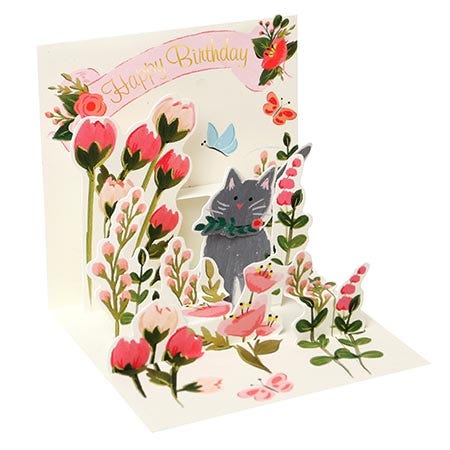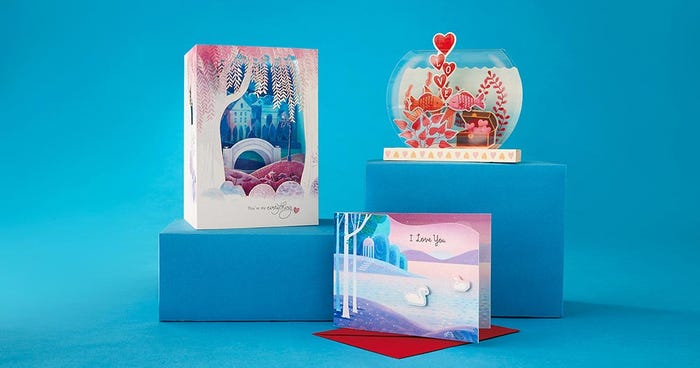How Retailers Are Driving Greeting Card Sales Year-RoundHow Retailers Are Driving Greeting Card Sales Year-Round
Grocers such as Schnucks are maximizing category trends. Grocers such as Schnucks are maximizing category trends.
February 14, 2019

In this digital age of texting, Tweeting and posting, greeting cards offer a more meaningful and tactile way to express sentiment and connect in a real way.
According to the Greeting Card Association in Washington, D.C., Americans purchase about 6.5 billion greeting cards each year, with annual retail sales of greeting cards estimated between $7 billion and $8 billion.
The key to grocery retailers making sales gains in this category may be as simple as implementing display and cross-merchandising strategies that get greeting cards in front of shoppers and remind them to buy.
For Schnucks, a St. Louis, Mo.-based grocer with 120 stores, this past holiday season marked record greeting card sales for its floral department. Floral Director Michael Schrader attributes the strong sales to a number of factors, including the retailer’s use of free-standing and movable card display fixtures throughout its stores.
“Some stores did phenomenal sales of as much as a 50% to 60% increase over last year,” says Schrader about Schnucks floral department’s 2018 holiday greeting card sales.
Schnucks worked with the Mason, Ohio-based Up With Paper to implement the free-standing cardboard greeting card displays in its floral departments and other areas of its stores.
“We also adjusted how we do things in our top-volume stores, and engaged in stronger communication with store leadership,” Schrader says. For example, while in past years stores could reorder holiday cards as needed, ordering was consolidated this year and stores received multiples of the free-standing, prefilled card display units. “We realized that we were giving up greeting card sales in our highest volume stores as they waited to receive reorders,” says Schrader.
Schnucks’ Gets Strategic
Schnucks also took a strategic approach to the location of the movable card displays. In one store, two of the cardboard greeting card displays were placed side by side in the vestibule of the store alongside the shopping carts. “We had tremendous sell through,” says Schrader of the placement.
Store leadership also reviewed its floral department greeting card sales each week in relation to the location of the display units. If a particular location wasn’t selling well, the display was moved to a new location in the store.
“Greeting cards are a guaranteed sale with no shrink, in many cases for the same price as a low-end bouquet,” says Schrader, who looks for ways to increase card sales all year long.
With Valentine’s Day approaching and a year of everyday and holiday occasions on the calendar, Schnucks’ floral department is working with Up With Paper to implement free-standing cardboard displays that can be moved around to optimal merchandising locations during each of the seven seasonal periods, as well as everyday Up With Paper pop-up cards in a permanent fixture in the floral department.

Photograph courtesy of Up With Paper
“The key to leveraging seasonal opportunities is to not only sell more greeting cards but other seasonal gift items as well,” says George White, president and chief operating officer of Up With Paper. “It is also important to have the seasonal products in main-drive aisles, rather than tucked away in a greeting card section, to maximize incremental sales.
For Valentine’s Day, Schnucks cross-merchandises items, including baked goods, chocolate-dipped strawberries, floral, greeting cards and liquor, to create an eye-popping destination for shoppers.
“We’re always asking ourselves: How can we make it easier for our customers?” Schrader says. Whether that’s creating a one-stop shop for Valentine’s Day or offering special light-up birthday cards and balloons in the floral department, Schnucks is making connecting in the modern age more convenient for its customers.
Millennials Moved by Mail
Another reason for Schnucks’ successful fourth-quarter holiday card sales, says Schrader, is that the retailer opted not to carry boxed holiday cards. “Millennials like to give different cards depending on the recipient, so they aren’t buying the boxed cards,” he says. What they are doing is buying more unique cards that speak to them personally and reflect the sensibilities of the recipient.
“Greeting cards are an interesting phenomenon in the digital age,” says White. “The emergence of digital greetings in the late ’90s, followed by social media, did have an initial negative impact on physical card sales, and I think a long-term depressive impact on physical card sales to Generation X, but as millennials are aging into traditional card-buying life stages, they are returning to greeting cards.”
Stacey Howe, VP and general manager of national accounts for Kansas City, Mo.-based Hallmark Cards, agrees. “[Our] research shows that millennials believe in the power of a greeting card. Millennials represent nearly 20% of the dollars spent on greeting cards, and are growing their spending faster than any other generational segment in the category.”
Life of the Party
For Phil Cowley, chief marketing officer of Design Design Inc. in Grand Rapids, Mich., every day brings reason to celebrate.
A full-line provider of greeting cards, paper tableware, unique birthday candles and party ware, Design Design offers grocers such as Carson, Calif.-based Bristol Farms and Dayton, Ohio-based Dorothy Lane Market a single solution for greeting cards and celebration supplies.
“Most specialty retailers have limited space for party and greeting cards, so it’s important to create consumer engagement by putting these categories together,” says Cowley. “It takes constant strategizing about how to keep the customer engaged at the highest level, and actually serve your guests.”
Continually offering new greeting cards is one way to capture the shopper’s attention. “We refresh our product line much more frequently than ever before because today’s shopper is making more frequent shopping trips,” notes Cowley.
Design Design refreshes its everyday greeting cards about 20% a year, and its birthday collections 50% a year. “Heavy spenders spend between $200 and $400 on greeting cards a year,” says Cowley, who encourages grocers to appeal to this customer and capture impulse sales by merchandising greeting cards as close to the checkout as possible.
Cross-merchandising greeting cards with party supplies is also a win, says Cowley, pointing to birthday candles specifically.
“Birthday candle numbers rival jewelry store numbers,” he says. “The turns are unbelievable—we’re talking $1,000 per square foot performance because they are so small.”
But Design Design isn’t only focused on parties. The sentiment for every Design Design greeting card is written by the same person who designs the card, with the goal of eliciting an emotional response from the recipient that turns the card from something that gets thrown away into a memorable keepsake.
Everyday Expression
Creating cards that are collectable rather than disposable is also top of mind for Hallmark. “In 2019, we are excited to expand Paper Wonder—our newest innovation that highlights the artistry of paper craft, which consumers tell us they increasingly associate with luxury and collectability,” says Howe.

Photograph courtesy of Hallmark
Hallmark first introduced Paper Wonder over the holidays with 20 different designs in five unique formats. This year it will offer new Paper Wonder cards for key seasons such as Valentine’s Day and Mother’s Day, as well as everyday occasions such as birthdays, weddings and anniversaries.
Hoping to spread positivity and encourage an everyday approach to giving and receiving greeting cards, Hallmark will launch an all-new assortment of greeting cards called Good Mail this spring. In addition to supporting youth art programs nationwide, Good Mail features diverse artists, styles and voices with unique, modern, real takes on life.
While Hallmark works with its grocery retail partners to increase greeting card sales through everyday and holiday displays in-store, it also recognizes the need to reach shoppers online.
“Hallmark research found that online grocery shoppers are more likely to be card buyers, which emphasized the need for us to create a dedicated e-commerce team focused on developing strategies, solutions and tools for our retail partners,” says Howe. “Adding a greeting card to a purchase doesn’t add much weight to the overall basket, but it does add significant sales.”
Cross-Merchandising in Floral
Up With Paper is introducing new “Trinkets,” mini cards that are well-suited to the floral section in grocery stores. Trinkets retail for $2.49, and feature miniature pop-ups on a card that can be added to a gift or hand delivered.
Cards by Occasion
The Greeting Card Association finds that women purchase an estimated 80% of all greeting cards. What occasions trigger a purchase?
Everyday card popularity
Birthday
Sympathy
Thank you
Wedding
Thinking of you
Get well
New baby
Congratulations
Seasonal card popularity
Christmas cards (1.6 billion units purchased, including boxed cards)
Valentine’s Day (145 million units, not including classroom valentines)
Mother’s Day (133 million units)
Father’s Day (90 million units)
Graduation (67 million units)
Easter (57 million units)
Halloween (21 million units)
Thanksgiving (15 million units)
St. Patrick’s Day (7 million units)
About the Author
You May Also Like






